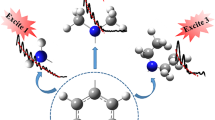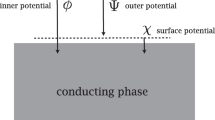Abstract
The low-energy chemical stereodynamics of these ion–molecule reactions D+ + D2 → D2 + D+, D+ + HD → DH + D+/D2 + H+, H+ + HD → H2 + D+/HD + H+ and H+ + H2 → H2 + H+ has been investigated by performing the quasi-classical trajectory calculations on the ground electronic state potential energy surface (11A′ PES). The polarization-dependent differential cross sections and the probability distributions of P(θ r ) and P(ϕ r ) have been calculated, compared and discussed within the center-of-mass frame and at the low collision energy of 100 meV. The calculation results indicate that the product scattering and the polarization of the product rotational angular momentum are sensitive to the reactant vibrational quantum number. Such sensitivity increases with the increasing value of mass factor. Moreover, the products from the reaction H+ + HD → HD + H+ show quite different scattering and polarization behaviors with reagent vibration excitation.









Similar content being viewed by others
References
Tennyson J, Miller S (1994) H3 + from first principles to jupiter. Contemp Phys 35:105–116
Jambrina PG, Aoiz FJ, Bulut N, Smith SC, Balint-Kurti GG, Hankel M (2010) The dynamics of the H++ D-2 reaction: a comparison of quantum mechanical wavepacket, quasi-classical and statistical-quasi-classical results. Phys Chem Chem Phys 12:1102–1115
Wrede E, Schnieder L, Seekamp-Schnieder K, Niederjohann B, Welge KH (2005) Reactive scattering of Rydberg atoms: H*+D-2 → HD + D*. Phys Chem Chem Phys 7:1577–1582
Li B, Han K-L (2008) The three-dimensional nonadiabatic dynamics calculation of DH(2)(+) and HD(2)(+) systems by using the trajectory surface hopping method based on the Zhu–Nakamura theory. J Chem Phys 128:114116
Kamisaka H, Bian W, Nobusada K, Nakamura H (2002) Accurate quantum dynamics of electronically nonadiabatic chemical reactions in the DH2+ system. J Chem Phys 116:654–665
Chu TS, Han KL (2005) Nonadiabatic time-dependent wave packet study of the D++H-2 reaction system. J Phys Chem A 109:2050–2056
Chu T-S, Han K-L (2008) Effect of Coriolis coupling in chemical reaction dynamics. Phys Chem Chem Phys 10:2431–2441
Chu T-S, Varandas AJC, Han K-L (2009) Nonadiabatic effects in D++ H-2 and H++ D-2. Chem Phys Lett 471:222–228
Chu T-S, Zhang Y, Han K-L (2006) The time-dependent quantum wave packet approach to the electronically nonadiabatic processes in chemical reactions. Int Rev Phys Chem 25:201–235
Li B, Chu T-S, Han K-L (2010) Non-Born-Oppenheimer dynamics calculations using the coherent switching with decay of mixing method. J Comput Chem 31:362–370
Lu RF, Chu TS, Han KL (2005) Quantum wave packet study of the H+ plus D-2 reaction on diabatic potential energy surfaces. J Phys Chem A 109:6683–6688
Amaran S, Kumar S (2007) Vibrational inelastic and charge transfer processes in H(+) + H(2) system: an ab initio study. J Chem Phys 127:214304
Carmona-Novillo E, Gonzalez-Lezana T, Roncero O, Honvault P, Launay J-M, Bulut N et al (2008) On the dynamics of the H(+) + D(2)(v = 0, j = 0) → HD + D(+) reaction: a comparison between theory and experiment. J Chem Phys 128:014304
Gonzalez-Lezana T, Aguado A, Paniagua M, Roncero O (2005) Quantum approaches for the insertion dynamics of the H++D-2 and D++H-2 reactive collisions. J ChemPhys 123:194309
Gonzalez-Lezana T, Honvault P, Jambrina PG, Aoiz FJ, Launay JM (2009) Effects of the rotational excitation of D-2 and of the potential energy surface on the H++D-2 → HD + D+ reaction. J Chem Phys 131:044315
Hankel M (2011) Coriolis coupling effects in the dynamics of deep well reactions: application to the H++ D-2 reaction. Phys Chem Chem Phys 13:7948–7960
Jambrina PG, Alvarino JM, Gerlich D, Hankel M, Herrero VJ, Saez-Rabanos V et al (2012) Dynamics of the D++H-2 and H++D-2 reactions: a detailed comparison between theory and experiment. Phys Chem Chem Phys 14:3346–3359
Zhang W, Li Y, Xu X, Chen M (2010) Isotope effects on the dynamics in the ion-diatomic collisions of D+, H+ with H-2 and D-2 molecules. Chem Phys 367:115–119
Zhang C, Zhang W, Chen M (2009) Theoretical Studies Of Stereodynamics For The H+ + H-2 (nu = 0–3, j = 0) → H-2 + H + reaction. J Theor Comput Chem 8:403–415
Han KL, He GZ, Lou NQ (1996) Effect of location of energy barrier on the product alignment of reaction A + BC. J Chem Phy 105:8699–8704
Wang ML, Han KL, He GZ (1998) Product rotational polarization in the photoinitiated bimolecular reaction A + BC → AB + C on attractive, mixed and repulsive surfaces. J Chem Phy 109:5446–5454
Wang ML, Han KL, He GZ (1998) Product rotational polarization in photo-initiated bimolecular reactions A + BC: dependence on the character of the potential energy surface for different mass combinations. J Phys Chem A 102:10204–10210
Alexander AJ, Aoiz FJ, Bañares L, Brouard M, Short J, Simons JP (1997) Stereodynamics of the Reaction O(1D2) + H2(v = 0) → OH(X2Πi;v = 0, N, f) + H: state-Resolved Linear and Rotational Angular Momentum Distributions. J Phys Chem A 101:7544–7557
Shaferray NE, Orrewing AJ, Zare RN (1995) Beyond state-to-state differential cross-sections—determination of product polarization in photoinitiated bimolecular reactions. J Phys Chem 99:7591–7603
Han KL (1997) Optical preparation of oriented and aligned reagents. Phys Rev A 56:4992–4995
Wang ML, Han KL, Cong SL, He GZ, Lou NQ (1998) Rotational alignment from the Sr(P-3(J)) + CH2ClI chemiluminescent reaction. Chem Phys 238:481–485
Wang ML, Han KL, Zhan JP, Huang JH, He GZ (1998) Rotational alignment from the reactions Sr(P-3(j)) + CCl4 and CHCl3. Chem Phys 236:387–392
Wang ML, Han KL, Zhan JP, Wu VWK, He GZ, Lou NQ (1997) Reaction dynamics of the Sr(P-3(J))+RI->SrI + R (R = CH3, CH3CH2) systems: rotational alignment, electronic state branching ratio and vibrational state population of products. Chem Phys 278:307–312
Zhan JP, Yang HP, Han KL, Deng WQ, He GZ, Lou NQ (1997) Rotational alignment of products from the NOCl + Ca chemiluminescent reaction. J Phys Chem A 101:7486–7489
Zhan JP, Yang HP, Han KL, Wang ML, Deng WQ, He GZ et al (1998) Rotational alignment of products from NOCl + Sr chemiluminescent reaction. J Chem Phys. 109:1819–1823
Zhang L, Chen MD, Wang ML, Han KL (2000) Product rotational polarization: stereodynamics of the reaction Cl(P-2(3/2)) + CD4(v = 0, j = 0)-> DCl(v(‘) = 0, j ‘= 1) + CD3. J Chem Phys 112:3710–3716
Zhang X, Han KL (2006) High-order symplectic integration in quasi-classical trajectory simulation: case study for 0(D-1) + H-2. Int J Quant Chem 106:1815–1819
Ju L-P, Han K-L, Zhang JZH (2009) Global Dynamics and Transition State Theories: comparative Study of Reaction Rate Constants for Gas-Phase Chemical Reactions. J Comput Chem 30:305–316
Chen MD, Han KL, Lou NQ (2003) Theoretical study of stereodynamics for the reactions Cl + H-2/HD/D-2. J Chem Phys 118:4463–4470
Chen MD, Han KL, Lou NQ (2002) Vector correlation in the H + D-2 reaction and its isotopic variants: isotope effect on stereodynamics. Chem Phys Lett 357:483–490
Chen MD, Tang BY, Han KL, Lou NQ (2001) Quasi-classical trajectory study of the DCl/HCl product branching ratios for the Cl + HD reaction on BW2 potential energy surface. Chem Phys Lett 337:349–354
Chen MD, Wang ML, Han KL, Ding SL (1999) Theoretical studies of scattering-angle resolved product rotational alignment for the reaction of Cl with vibrationally excited methane. Chem Phys Lett 301:303–308
Li RJ, Han KL, Li FE, Lu RC, He GZ, Lou NQ (1994) ROTATIONAL ALIGNMENT OF PRODUCT MOLECULES FROM THE REACTIONS SR + CH3BR, C2H5BR, N-C3H7BR, I-C3H7BR BY MEANS OF PLIF. Chem Phys Lett 220:281–285
Cai MQ, Zhang L, Tang BY, Chen MD, Yang GW, Han KL (2000) Quasiclassical calculation of the chemical reaction Sr plus HF. Chem Phys 255:283–289
Liu YF, Meng HY, Han KL (2005) Theoretical study of the stereodynamics of the reaction Cl + C3H8 → C3H7 + HCl. Chem Phys 309:223–230
Fan GH, Han KL, He GZ (2013) Time-dependent Density Functional-based Tight-bind Method Efficiently Implemented with OpenMP Parallel and GPU Acceleration. Chin J Chem Phys 26:635–645
Han KL, Zhang L, Xu DL, He GZ, Lou NQ (2001) Experimental and theoretical studies of the reactions of excited calcium atoms with ethyl and n-propyl bromides. J Phys Chem A 105:2956–2960
Alberti M, Gimenez X, Aguilar A, Urena AG (1995) Angular momenta correlation in kinematically constrained reactions: application to the BA + HI- BAI + H system. Mol Phys 85:949–963
Acknowledgements
This work is supported by the Natural Science Foundation of Shandong Province of China under the Grant No. ZR2014AM025.
Author information
Authors and Affiliations
Corresponding author
Rights and permissions
About this article
Cite this article
Lü, R. Low-energy stereodynamics in the ion–molecule reactions D+ + D2/HD and H+ + H2/HD: reagent vibrational excitation effect and mass factor effect. Theor Chem Acc 137, 58 (2018). https://doi.org/10.1007/s00214-018-2233-0
Received:
Accepted:
Published:
DOI: https://doi.org/10.1007/s00214-018-2233-0




